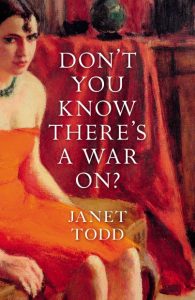On Writing, by Janet Todd
I always wanted to write fiction. Over the years I started  several novels—occasionally I even finished them. In subject they ranged from expatriate life in post-independence Ghana to a fictionalised biography of Mary Wollstonecraft’s unhappy sister. (Most attempts have gone out in black bin bags.)
several novels—occasionally I even finished them. In subject they ranged from expatriate life in post-independence Ghana to a fictionalised biography of Mary Wollstonecraft’s unhappy sister. (Most attempts have gone out in black bin bags.)
I had a family to support and it’s a lot easier to earn a living as an academic than as a novelist (it was long before the explosion of creative-writing courses which have been such a boon to authors). Now at last I have the time and feel just a little less vulnerable to the possibility of a mean review!
Don’t You Know There’s a War On? takes its title from a common saying during the Second World War: whenever anyone asked for slightly better treatment or some semblance of service, the stock sniffy reply was ‘Don’t you know there’s a war on!’ My mother remembers this vividly: it became a saying in our house as I was growing up.
I started writing my novel when in the 1980s I returned to England after a gap of 20 years. Each summer I had visited for a short stay (except 1976, when my novel is set!). On each occasion I arrived with more fashionable liberal ideas—I was teaching at American universities. These pushed against the old cultural and political certainties of the previous generation. I was impatient with those who’d not moved on from old-style patriotism to condemn imperialism, who still revered the British Empire and were proud of England’s historical and literary past. Meanwhile, my increasingly loud feminist views on equal opportunities and the importance of paid work clashed with the opinions of women who valued the discreet and caring feminine roles. (Things have moved on now, in feminism and my thinking!)
The immediate inspiration for the plot of Don’t You Know There’s a War On?’ was a childhood memory. In the small town where I partly grew up there was a detached house in a rather posh road. A lady–I assume a widow– lived there with an only daughter. This daughter had become a doctor. I had never heard of a woman doctor and was deeply impressed at the notion. The next thing I learnt was that the daughter had had a ‘breakdown’—equally impressive and mysterious to me– and had returned home. When I passed the house, I noticed the curtains were closed in the sitting room and front bedroom. The idea of these two women shut up in a house together has haunted me. It seems an image both of an attenuated family and of loneliness.
Most of my early reading was in classic fiction—usually adventure stories, I wasn’t into ‘girlie’ books– and there’s not much about mothers there. In general, heroines were orphans or away from home, daughters, not mothers. If there was a mother surrogate– Miss Haversham or Jane Eyre’s aunt– she was usually monstrous. I was struck by one fairy story about a mother who turns out to be a witch. The child escapes into a sack of dreams. I was interested in the idea of the monstrous mother. Could she be humanised in a novel? Could she be made not likeable—my Joan is never that!–but understandable?
I once thought of calling my novel ‘The bitter tears of a post-war woman’. The book’s main period is the 1940s and 1950s, when the Second World War was still the defining event. In its idea of mothering and motherhood, it seems as far from us now and our child-centred notions as the Victorian era itself. Women had just emerged from 6 years of war with its rationing, privation, excitement and opportunities. They outnumbered men. The emphasis was on wifehood rather than motherhood, keeping your man more than keeping your child.
Then came the social and cultural revolutions of the 1960s and 1970s. These would leave many older women far behind. My main character, Joan, is one of these. She clings onto the war and its values, despite the war destroying her. As a result, she’s simply out of place and time. Partly through these changes and largely through her own bitter failure to adapt, she’s become a misfit and outsider.
She is aware of encroaching society and has the keen sense of embarrassment and feeling of insecurity typical of the lower middle class. In Hyacinth Bucket in the television series Keeping up appearances, the desire for respectability is entirely comic. I wanted Joan to have some sense of the absurd while still holding on to her pride and rigid values.
In 1976, the year of an amazing un-English heatwave, Maud persuades her mother to begin writing a part memoir, part journal. It will describe a past they’ve never discussed and comment on the increasing menaces of the present as other people intrude on their claustrophobic life. The self-expression which Joan has always denied herself releases what has long been suppressed. It breaks down her rigid self-control and lets her admit her lush imaginative fantasies. Her catastrophic confessions to herself threaten to engulf both her and her daughter.
I was never tempted to give much of a voice to Maud because it would make the mother more monstrous. Joan is monstrous of course but I wanted to convey her own sense of the macabre comedy of her situation–as well as the pathos of her inner rebellious life.
—
Janet Todd is a former President of Lucy Cavendish College, Cambridge, where she established the Lucy Cavendish Fiction Prize. She is the author of Aphra Behn: A Secret Life, 2017, and three linked biographies on Mary Wollstonecraft, her Irish protégée Lady Mount Cashell, and her daughters Fanny Wollstonecraft and Mary Shelley. Jan has published a memoir, Radiation Diaries, and three novels. The most recent, Don’t You Know There’s a War On? is published by Fentum Press in April 2020.
DON’T YOU KNOW THERE’S A WAR ON?
 The Second World War is over. England is losing its empire, world status and old elite values. The Empire strikes back with mass immigration, while the government soothes its people with welfare, the NHS, televisions and refrigerators.
The Second World War is over. England is losing its empire, world status and old elite values. The Empire strikes back with mass immigration, while the government soothes its people with welfare, the NHS, televisions and refrigerators.
At the centre of the novel is the contemptuous Joan Kite, at odds with all the changes imposed on the country in the post war period. Shut up in a house with her only daughter, she refuses to compromise and adapt, pouring vitriol on anyone who seeks to enter their lives. After years of frugality, patriotism, service and excitement, she is angry at the contracted existence she’s been delivered and at the manner in which her aspirations to upper-middle-class culture have been thwarted.
When her daughter is threatened, she begins a diary to investigate her past before and during the war. In it she gives rein to a flamboyant imaginary life and to an energetic loathing for the reality of a diminished England.
During the freak hot summer of 1976, as water is rationed and ladybirds invade their home, the intimacy of mother and daughter intensifies. Their lives unravel within the claustrophobia of their semi-detached house behind closed velvet curtains.
Category: On Writing

























